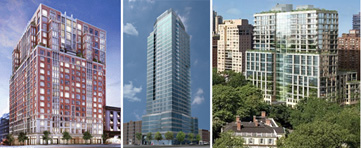Trending
Move over, UWS: It’s the UES’s turn
 |
Last year at this time, the Upper West Side consistently bested every other neighborhood in town, statistics-wise, as astronomical closings at 15 Central Park West produced impossible-to-beat sales figures for the neighborhood.
But now the Upper East Side has arrived — sort of.
Now that closings are few and far between at 15 Central Park West, Robert A.M.’s Stern’s incredibly successful limestone condo, the way is clear for chart-topping deals at Manhattan House, Stern’s Brompton and other new developments on the Upper East Side.
And accordingly, quarterly reports showed eye-popping price increases in the neighborhood. But while the Upper East Side may have some advantages over other areas, brokers say the statistics are largely an illusion created by lagging condo deals. It appears the neighborhood’s time to shine has been cut short by the credit crisis.
According to a market report by Streeteasy.com based on closed sales for the first quarter, the Upper East Side was the only Manhattan neighborhood to show gains in overall median price, jumping to $1.124 million in the first quarter of 2009, up 5.4 percent from last quarter and 24.9 percent from the same period last year. By contrast, Streeteasy.com found, the overall median price on the other side of Central Park dropped 29.6 percent year-over-year to $695,000 and 14.2 percent from last quarter.
A closer look at the data reveals that condo sales drove the increase. While the median co-op sales price in the neighborhood dropped 2.6 percent year-over-year to $745,000, the prices in new developments skyrocketed 107 percent to $2.98 million, according to Streeteasy.com. The Corcoran Group’s report showed a similarly astronomical 95 percent increase in median price to $1.83 million, up from $938,000 in the same quarter last year.
Experts agree that those figures are a result of closings at pricey new developments like the Brompton, 255 East 74th Street and 170 East End Avenue. The sales likely occurred more than a year ago, said Derrick Gross, a business analyst at Streeteasy, meaning they reflect the pre-Lehman Brothers marketplace.
Still, Gross said, buyers in Upper East Side buildings may be less likely to break their contracts than they would be in other parts of the city. One reason is that prices have not declined as fast there as they have in some areas.
“If you’re in the Financial District and your apartment is worth less today than it was when bought it, you’re more likely to leave that deposit,” he said. “You can wait a few months and buy a new apartment and still save money.”
The Upper East Side, Midtown on the East Side and Yorkville were among the five neighborhoods with the most closings in the city, according to Streeteasy.com, with 85, 106 and 81, respectively.
He added that deposits at many of the new family-sized Upper East Side condos may be harder to walk away from.
“A lot of those new developments were very family-focused,” he said. “They are more expensive because they’re larger.”
But newer developments in the area haven’t fared as well, falling victim to the credit crunch and Wall Street meltdown. Buildings like the Isis at 303 East 77th Street, he said, have sold very few units, while a bevy of brokerages changes at Manhattan House, Georgica and Miraval Living indicate they may not be doing as well as the developers hoped.
Brokers confirmed that the Upper East Side is not exempt from the market slowdown.
“It’s rough out there,” said Noble Realty’s Richard Goldberg, who has several Upper East Side listings, adding that the pain doesn’t seem to have spared the neighborhood. “It’s across the board.”
Elaine Clayman, a senior vice president at Brown Harris Stevens, agreed that the Upper East Side isn’t exempt from the downturn.
“People now are not as location conscious as value conscious,” she said. “I think people are more open to location, as long as they get the right price.”
She added that high condo prices don’t tell the whole story, since developers may be throwing in concessions like years of maintenance payments or free renovations.




